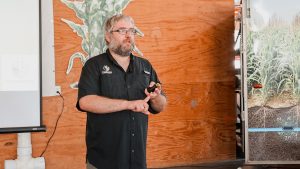See the entire presentation, live farmer questions, and the Yarrick family’s firsthand testimony.
In Missouri, farmers are constantly adapting to challenges—rolling topography, variable soils, and summer drought stress. At the 2025 Rich Hill, MO Field Day, hosted by NutraDrip + Holganix, growers had the chance to see firsthand how subsurface drip irrigation (SDI) is helping farmers overcome these issues.
The featured speaker, Travis Rokey — NutraDrip’s Missouri Sales Representative and Director of Ag Technologies — delivered a full technical presentation, answered live questions from farmers, and facilitated a panel with the Yarrick family, a multi-generation Missouri farm family using SDI.
This blog post breaks down the highlights of the day: Travis’s talk, the Q&A session, and the Yarricks’ insights.
Why Drip Irrigation is Gaining Ground in Missouri
Missouri’s landscape highlights the beauty of subsurface drip irrigation (SDI), as its rolling hills and irregular fields can be fully and evenly irrigated with drip tape and pressure compensating emitters; no dry corners or wasted water through evaporation. The benefits of SDI are numerous: Efficient water delivery – Water is applied directly to the root zone, eliminating evaporation losses.
- Flexible field design – Odd-shaped fields, small patches, and corners can be fully irrigated.
- Improved ROI – SDI pays back fastest on sandy soils and low water-holding capacity fields where water is the main limiting factor.
- Sustainability – By conserving water and fertilizer, SDI builds long-term soil health and extends aquifer life.
Travis Rokey’s Presentation: Building a Drip System
Travis walked attendees through the key building blocks of a drip irrigation system:
Water Source Options
- Ponds, wells, and rivers can all serve as water sources.
- Water quality is critical: high sodium, bicarbonates, or chloride levels can harm both crops and drip lines if not addressed.
Water Needs
- A general target is 5 gallons per minute per acre.
- For a 100-acre field, that means 500 gpm, enough to apply a quarter-inch of water per day during hot, dry periods.
System Design & Engineering
- Fields are divided into zones, with pipe sizes and drip tape style engineered to account for elevation changes and soil types.
- Pressure-compensating emitters ensure even water flow across rolling hills.
Installation
- Drip tape is buried 12–16 inches deep, typically spaced 60 inches apart.
- RTK guidance ensures rows are planted in alignment with drip lines, keeping roots within reach of water and nutrients.
Filtration & Fertigation
- Sand media filters and disc filters remove sediment before it reaches the drip lines.
- Fertilizer is injected precisely through the system, avoiding over-application and maximizing uptake.
Automation
- Controllers monitor flow and pressure, trigger automatic filter backflushing, and send alerts for leaks or plugging issues.
- Systems can be controlled via a mobile app, reducing the need to be in the field.
Longevity & Maintenance
- With proper care, SDI can last 30–50 years underground.
- Seasonal tasks include flushing lines, checking for leaks, and occasional acid flushes to clean buildup.
Audience Q&A: Farmers’ Toughest Questions about SDI
After the presentation, Travis invited growers to ask direct questions. These conversations gave the field day an open, farmer-to-farmer feel.
- Drainage Tile & Drip – Farmers asked how irrigation water interacts with tile lines. Travis explained that when soil becomes saturated from rain, excess water can move into tile lines, but proper irrigation scheduling avoids this issue, especially when soil moisture probes are used and monitored.
- Emitter Lifespan – Clean water and good filtration keep emitters running smoothly for decades. NutraDrip has serviced systems more than 30 years old that still function as designed.
- Pivot vs. Drip Costs – Full-swing pivots are generally cheaper upfront, but drip covers every acre and eliminates evaporation losses. On half-swing pivots, costs are often similar to drip — but drip delivers better long-term ROI.
- Tape Longevity – Early drip tape used welded seams that could eventually fail. Modern seamless extruded tape avoids this issue and can last up to 50 years underground.
- Ease of Repairs – A small leak can be fixed in minutes with a splice kit — much less downtime than repairing a pivot tower or gearbox.
One farmer summed it up: “With pivots, you’re always losing something to evaporation or corners. With drip, every acre gets water.”
Farmer Panel: The Yarrick Family’s Experience
The session concluded with a panel featuring the Yarrick family, a multigenerational family who farm together. Their farm has been in the family for over a century, and adopting SDI was a decision driven by both efficiency and future sustainability.
What the Yarricks Shared:
- Yield Improvements – Fields that had failed in dry years are now producing consistently. In one example, irrigated soybeans outyielded non-irrigated beans by 25 bushels per acre.
- Moisture Monitoring – Probes give real-time soil data, showing when crops need water and preventing overwatering.
- Remote Operation – Cody Yarrick explained how he can control the system entirely from his phone. Solar-powered radios and automation mean he doesn’t need to be in the field to manage irrigation.
- ROI Confidence – The family sees SDI as a long-term investment. With systems lasting multiple decades, the returns compound year after year.
Their testimony resonated strongly with the audience. As Travis put it: “I can tell you all the benefits of drip, but when it comes from a farmer, it carries more weight.”
Key Takeaways from Rich Hill Field Day
- SDI fits Missouri farms: rolling topography and irregular fields are no longer barriers to efficient irrigation.
- Longevity matters: with proper care, systems can last 30–50 years, making SDI a generational investment.
- Water efficiency is unmatched: every drop counts, and every acre gets covered.
- Farmers trust other farmers: real-world results from families like the Yarricks carry more weight than brochures or sales pitches.




